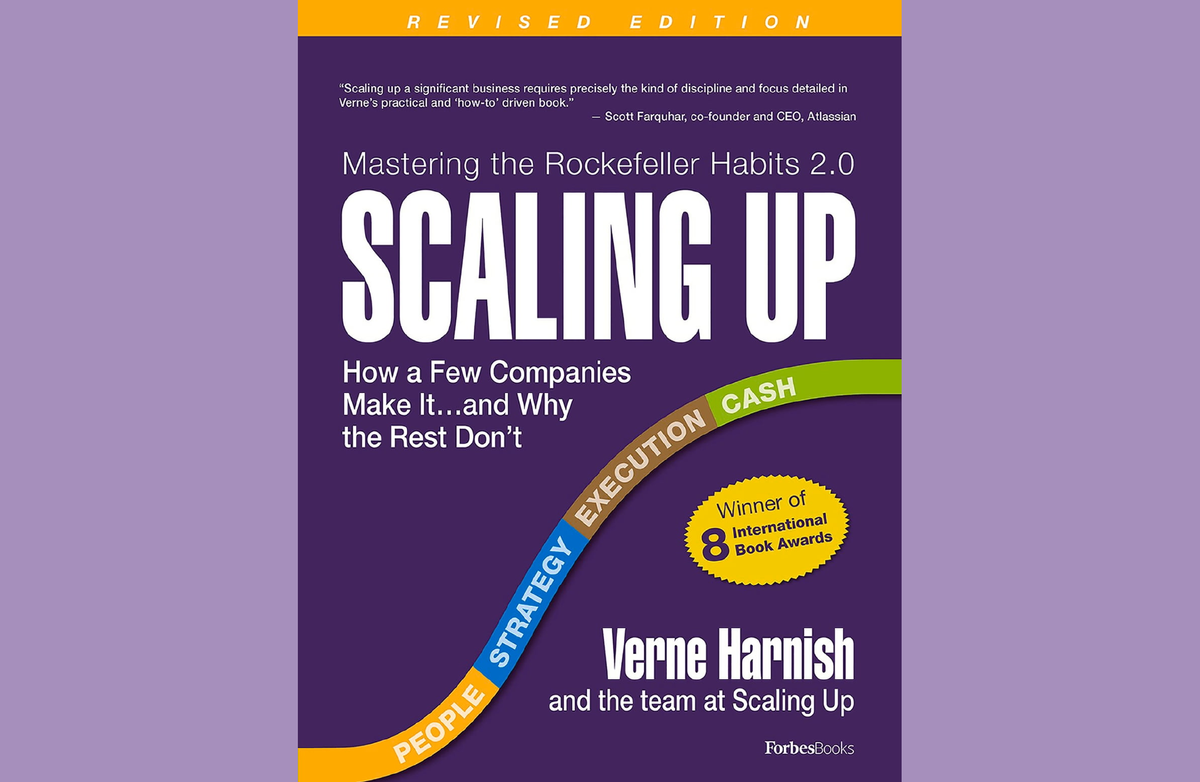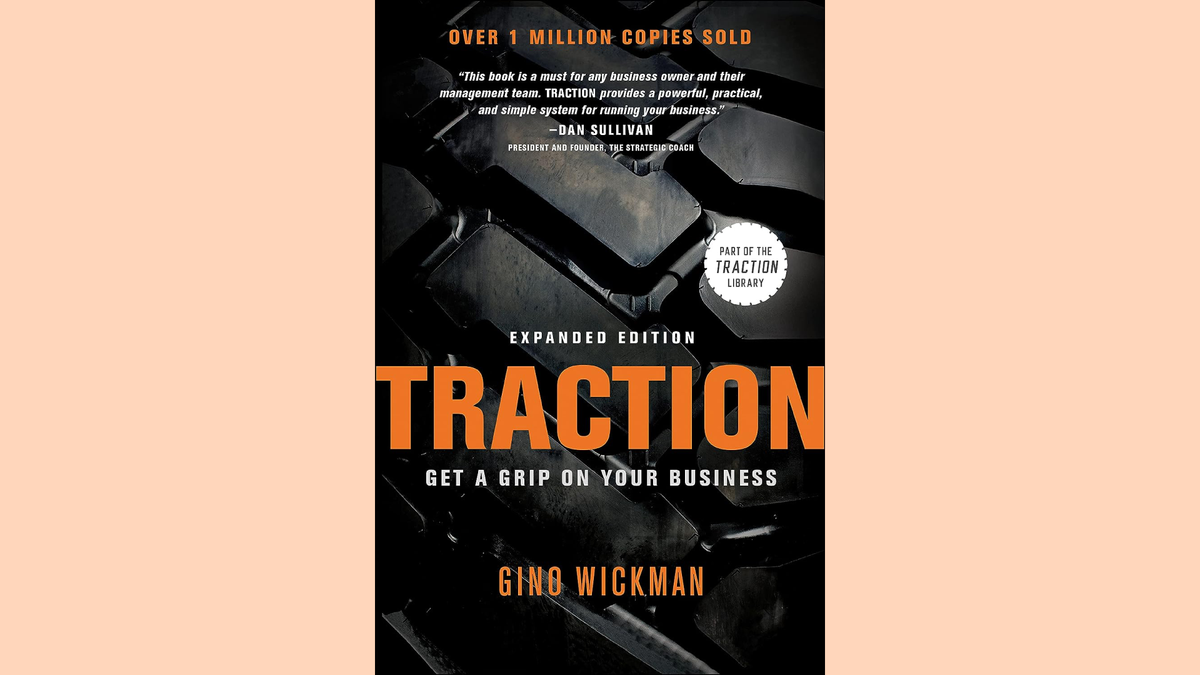How To Reap Rewards Of Vision And Execution Alignment
Discover how founders can seize the “Reward” stage with BHAGs and OKRs, driving long-term success. Learn from Reed Hastings’ journey with Netflix and explore insights from “Scaling Up” and “Traction” to build winning systems and culture.

The entrepreneurial journey is full of challenges, but when vision and execution align, the reward is worth every sacrifice. As founders and CEOs, achieving success is not just about reaching financial milestones—it’s about turning a bold vision into reality, ensuring that your team thrives, and building systems that allow the company to scale.
The “Reward” stage of the founder’s journey happens when everything starts to click. Your Big Hairy Audacious Goal (BHAG) provides the overarching direction, while Objectives and Key Results (OKRs) help break that vision into measurable, achievable steps. When these two elements come together, the transformation is extraordinary—not just for the business but also for the people and culture within it.
“Success is the result of a vision so bold it seems unreachable, paired with execution so focused it makes the impossible inevitable.”
What is “The Reward” for a Founder?
The “Reward” stage of the hero’s journey is when the hero finally obtains the prize they’ve been seeking. In a business context, this could be hitting major revenue milestones, achieving product-market fit, gaining market leadership, or seeing your vision come to life. However, the most meaningful rewards are often deeply personal, such as:
- Financial success: A moment when the company becomes profitable, secures significant investment, or reaches a financial breakthrough like an IPO.
- Product validation: The reward of seeing your product genuinely resonate with customers and transform lives.
- Market leadership: When your company becomes the benchmark in your industry, shaping the future of your market.
- Personal fulfillment: Experiencing the deep satisfaction of knowing your work has made a lasting impact, whether improving lives, creating jobs, or changing industries.
- Team loyalty and culture: Seeing your team not just follow orders but take ownership, build on your vision, and carry it forward.
Deep personal fulfillment has come when I’ve watched people thrive within robust systems. These systems could be processes or templates, but they feel like more than that: it’s like discovering a winning playbook—a rhythm that propels the business and its people forward.
At Apollo Advisors, I’ve witnessed clients undergo remarkable transformations. They come in needing clarity and structure. They map out processes, build support systems, and—most importantly—align their culture with their vision. The results are astonishing. Everything begins with a BHAG, and suddenly, everything in their OKRs—the people, the product, the profits, and the promotion—falls into place.
“True fulfillment as a founder comes from building systems that let others thrive—where your people and culture move in sync with your vision.”
The Power of BHAG: Setting the Vision That Drives the Reward
For any founder, the journey begins with a vision, where the Big Hairy Audacious Goal (BHAG) comes into play. The BHAG is your North Star—a bold, audacious goal that seems almost impossible but is powerful enough to rally your team for the long haul.
For example, think of Elon Musk’s goal of making life multi-planetary. This isn’t just about launching a successful business; it’s about changing the course of humanity. Similarly, the BHAG you set for your company should be ambitious, transformative, and clear enough to inspire everyone.
How the BHAG Connects to the Reward:
- Clarity of Purpose: The BHAG provides a clear, long-term vision. When you reach the “Reward” stage, you’ll see how this bold vision has guided you and your team through challenges, bringing focus to everything you do.
- Unified Team: The BHAG rallies your team around a single cause. When you achieve part or all of that BHAG, it’s a collective victory—a reward to which everyone in the company feels deeply connected.
- Checkpoint, Not the End: The BHAG is a long-term vision. Achieving the “Reward” is a milestone on the path, not the final destination. This reward serves as a moment to reflect on progress and recalibrate for the next leg of the journey.
- Transformation: The BHAG isn’t just about growth or revenue; it’s about changing the game. Whether transforming an industry, disrupting old models, or making a lasting social impact, the BHAG sets you up to receive a more profound reward—the knowledge that your vision has made a difference.
“A BHAG isn’t just a goal—it’s the vision that pulls you through every challenge toward the reward of changing the world.”
OKRs: The Roadmap to Achieving the Reward
While the BHAG defines the destination, the Objectives and Key Results (OKRs) provide the roadmap. OKRs break down your audacious goal into specific, measurable steps, ensuring that every quarter, every team member, and every project moves you closer to the BHAG.
How OKRs Align with the Reward:
OKRs allow you to set quarterly objectives and measure key results, making progress tangible. When you reach the “Reward” stage, each OKR represents a small victory, building toward the ultimate prize.For instance, an OKR like “Increase customer retention by 20%” supports a BHAG of becoming the market leader. When this OKR is met, it represents a clear, incremental reward—a sign that the business is moving in the right direction.
OKRs ensure everyone in the organization is aligned with the BHAG. When the company finally hits the “Reward” phase, it’s not just because of one person’s efforts—it’s the result of a collective effort where everyone knows their role and the impact they’ve made.
OKRs provide a framework for accountability. Each department and individual is responsible for achieving specific key results that feed into the larger goal. When the reward is finally realized, how each person and team contributed is clear.
The entrepreneurial journey is full of unexpected challenges, much like the trials heroes face. OKRs allow you to adjust course while keeping your eye on the BHAG. The reward comes from sticking to a rigid plan and strategically adapting while moving toward your ultimate goal.
OKRs are also a tool for celebrating small victories. As you check off key results, you build momentum and morale. By the time you reach the “Reward” stage, you’ve already celebrated multiple successes, which makes the ultimate reward even more meaningful.
“OKRs turn vision into reality by breaking the impossible into achievable steps—where each milestone is a reward.”
Resistance to Systems: The Founder’s Dilemma
In my experience, one of the most significant challenges founders face is the resistance to embedding systems into their companies. There’s a romanticized notion in the startup world about the scrappy early days—the adrenaline, the fast-paced decision-making, the sheer creativity that comes with chaos. But there’s a point where that chaos becomes a liability.
The real risk is lacking the courage to transition from a scrappy startup to a refined, maturing business. Founders fear systems will stifle innovation or slow growth, but systems create freedom. Your team can innovate and operate within a structured, scalable framework when you have the right processes.
The reward comes when you see the transformation: your business no longer depends solely on your hustle. It becomes self-sustaining. You’ve built a machine that can scale without your constant involvement. That’s when the BHAG and OKRs pay off—the systems you’ve built allow others to thrive, innovate, and grow the business to levels you couldn’t have achieved alone.
“The shift from chaos to systems is the bridge between survival and lasting success—where the true reward lies.”
Seizing the Reward: Fulfillment in Seeing People Thrive
The deepest personal fulfillment comes from seeing people thrive within these robust systems. At Apollo Advisors, I’ve witnessed clients map out processes, build supporting frameworks, and align their culture to their vision. The transformation is remarkable when they embrace their BHAG and execute through OKRs. The chaos subsides, and a winning rhythm takes over.
It’s about more than profits or market share—it’s about seeing a company evolve, witnessing individuals grow, and knowing that the systems you’ve put in place will continue to drive success long after you’ve stepped away. That is the ultimate reward.
The BHAG gave them the vision, the OKRs gave them the tools, and the transformation became the reward—one experienced by the founder and everyone in the organization.
“The tremendous success as a founder isn’t just building a business—it’s creating a system where others can thrive and take the vision further than you imagined.”
Rewarding Reading
As a founder entering your journey’s “Reward” stage, you must have the tools and frameworks to sustain success. The following books—“Scaling Up” by Verne Harnish and “Traction” by Gino Wickman—offer practical strategies that align with both the BHAG and OKR systems, helping founders manage growth, build efficient systems, and ensure that their company thrives in the long term.

1. “Scaling Up” by Verne Harnish
Scaling Up: How a Few Companies Make It…and Why the Rest Don’t is a critical resource for founders transitioning from the scrappy, early-stage startup phase to a scalable business model. Harnish provides a practical framework for managing the complex challenges of scaling a company, focusing on four critical areas: people, Strategy, Execution, and Cash.
Key Insights from “Scaling Up”:
- Building a High-Performance Team: At the “Reward” stage, one of the most gratifying experiences is seeing your team grow and excel. Harnish emphasizes the importance of building a solid team aligned with the company’s vision, mission, and values. He introduces tools for identifying A-players and creating a culture of accountability and empowerment. As a founder, seeing your team follow and own the vision is vital to the reward.
- Strategy and the Power of Focus: Scaling Up stresses the importance of a clear strategy aligning with your BHAG. Harnish provides tools like the One-Page Strategic Plan (OPSP) to ensure that every part of the business works toward the same long-term objectives. This kind of strategic clarity is critical as the company grows, ensuring that each department and team is aligned with the company’s mission.
- Execution and Rhythm: One of Harnish’s core messages is the need for a rhythm of execution—a set of daily, weekly, and quarterly habits that keep the company aligned and moving forward. This rhythm of accountability mirrors the structure of OKRs, ensuring that each team member has measurable goals tied to the company’s overarching vision.
- Cash Flow and Financial Systems: Financial success is critical to the “Reward” stage. Harnish provides essential guidance on managing cash flow, often the Achilles’ heel of fast-growing companies. From optimizing your business model to managing working capital and profitability, Scaling Up offers clear strategies to ensure your business remains financially healthy as it scales.

2. “Traction: Get a Grip on Your Business” by Gino Wickman
Traction: Get a Grip on Your Business introduces the Entrepreneurial Operating System (EOS), a comprehensive framework for aligning a company’s operations with its long-term goals. The EOS focuses on six key components: Vision, People, Data, Issues, Process, and Traction, collectively providing the structure for sustained growth and success.
Key Insights from “Traction”:
- Vision and Clarity of Purpose: Wickman’s EOS begins with establishing a clear and shared vision for the company. This ensures everyone knows where the company is headed and how their role contributes to its success. Like a BHAG, this vision provides long-term direction for the company, but detailed, actionable steps support it.
- Connection to the Reward: Achieving the “Reward” often comes from seeing your vision materialize. Wickman’s focus on clarity and alignment ensures that when the reward is realized, it’s not just a personal victory but a collective success, where everyone in the organization understands their role in achieving the company’s goals.
- People: Building the Right Team: Like Verne Harnish, Wickman stresses the importance of having the right people in the right seats. This means hiring talented individuals and ensuring they are aligned with the company’s vision and culture. The EOS People component is about building a team that takes ownership of the company’s success and drives it forward.
- Data-Driven Decision Making: Traction emphasizes the importance of data-driven decisions. Founders often rely on gut instinct in the early stages, but as the company grows, data becomes a crucial tool for driving the right decisions and ensuring progress. Wickman introduces the concept of the scorecard, a tool that tracks key metrics and ensures that the company is on track to meet its goals.
- Processes that Scale: In the EOS framework, processes are critical for ensuring the company can scale without losing efficiency or quality. Wickman encourages founders to document and simplify critical processes, ensuring they are repeatable and scalable. This systemization is crucial for building a company that can grow without constantly relying on the founder.
- Traction for Continuous Growth: Traction focuses on building momentum—ensuring that the company is always moving forward and achieving measurable progress. Like OKRs, Wickman’s EOS uses 90-day rocks to break long-term goals into manageable, achievable milestones. This system ensures the company stays on track and maintains momentum toward its larger objectives.
How These Books Empower Founders in the “Reward” Stage
Both “Scaling Up” and “Traction” are essential guides for founders looking to sustain success at the “Reward” stage of their journey. Both books emphasize the importance of having a long-term vision (BHAG) that serves as the company’s guiding star. This vision ensures that the reward isn’t just a financial milestone but the realization of something much bigger.
The OKR-like systems in both books allow founders to break down their vision into measurable, actionable steps. This ensures that the path to the reward is clear and that every team member is aligned in pursuing the company’s goals.
As companies grow, the need for robust systems becomes critical. Both books provide detailed frameworks for building scalable processes, ensuring that growth is sustainable and the company can thrive long after achieving the initial reward.
Finally, both books emphasize the importance of building a high-performing team and creating a culture that supports ongoing success. The reward becomes much more meaningful when shared with a team just as invested in the company’s vision as the founder.
“Sustained success isn’t about one big win—it’s about creating the systems, culture, and momentum that ensure future victories.”

Case Study: Reed Hastings – Netflix’s Transformation and Triumph
Reed Hastings, co-founder and CEO of Netflix, is one of the most compelling examples of a founder successfully navigating the “Reward” stage of the hero’s journey. Hastings’ journey with Netflix is a masterclass in visionary leadership, innovation, and bold decision-making. By embracing a Big Hairy Audacious Goal (BHAG) and utilizing a disciplined approach to execution—similar to the OKR framework—Hastings transformed Netflix from a DVD rental service into the global streaming powerhouse we know today.
This case study showcases how Hastings reaped the financial and market rewards and revolutionized an entire industry. His BHAG and OKR-like focus on technology, content, and global expansion allowed Netflix to thrive, whereas other competitors, such as Blockbuster, failed.
Netflix’s Bold BHAG: Becoming the World’s Leading Entertainment Service
In the early 2000s, Netflix was known primarily for its DVD rental-by-mail service, which disrupted traditional video rental stores like Blockbuster. However, Hastings had a far-reaching vision—a BHAG that went beyond DVDs. He aimed to position Netflix as the world’s leading entertainment service, pioneering a global shift toward on-demand streaming.
At the time, this goal seemed almost impossible. Streaming technology was still in its infancy, with broadband speeds and consumer behavior still needing to be optimized for streaming large amounts of video. Most households were still reliant on physical media like DVDs. Competitors like Blockbuster were still dominant, with brick-and-mortar stores nationwide. But Hastings envisioned a future where content could be instantly streamed, giving consumers access to a vast library of movies and TV shows with just a few clicks.
How the BHAG guided Netflix’s transformation:
Hastings’ BHAG was to redefine how people consume media. This long-term vision guided every major decision at Netflix. Hastings didn’t just want to evolve within the current industry—he aimed to change the game entirely by making streaming the primary way people watched content.
“We weren’t just trying to be the best in DVD rentals—we were aiming to become the future of entertainment. That goal gave us the courage to take bold risks.”
This BHAG pushed Netflix to invest heavily in streaming technology, even when it wasn’t profitable yet. Hastings believed consumers would eventually embrace streaming if the technology offered high-quality, seamless viewing. His bold investment in infrastructure, user experience, and broadband partnerships set the stage for Netflix’s future success.
Achieving dominance in the streaming market was a checkpoint on Hastings’ journey. The ultimate reward for Hastings wasn’t just building the largest streaming service—it was about being ahead of the curve, constantly innovating, and eventually becoming a leader in original content creation.
Hastings transformed Netflix from a niche DVD rental service into the dominant global entertainment brand by adhering to this audacious goal. His BHAG provided the long-term vision that united his team and ensured that Netflix could evolve faster than its competitors.
OKRs in Action: Driving Netflix’s Growth and Execution
To achieve his BHAG, Hastings needed a robust system of execution that could guide Netflix through each growth phase. While Netflix may not have explicitly followed the OKR framework, the company’s approach to setting clear objectives and tracking measurable results mirrors the OKR methodology.
Here’s how Netflix’s key objectives aligned with its vision and ultimately led to its “Reward” phase:
1. Scaling Technology: Building the Foundation for Streaming
Early on, Netflix set a crucial objective: to build the technical infrastructure required to stream content seamlessly to millions of users. This wasn’t a simple task—internet speeds were slow then, and there was widespread skepticism about streaming as a viable technology.
One of Netflix’s primary critical results for this objective was ensuring consistent video quality, regardless of the user’s broadband speed. This meant investing in cutting-edge technologies like adaptive bitrate streaming and building partnerships with internet service providers (ISPs) to optimize delivery.
“Streaming wasn’t just an option—it was our future. We needed to ensure our technology could scale as fast as consumer demand would.”
The investment in scalable technology paid off. By 2007, Netflix launched its streaming service, and as broadband access improved, Netflix’s user base skyrocketed. The rewards were technical success and market leadership, such as Netflix. It became the go-to platform for streaming content, leaving competitors scrambling to catch up.
2. Shifting from Distributor to Content Creator: Original Programming
Another significant objective for Netflix was to become a content creator rather than just a distributor. Hastings realized early on that licensing content from studios had limitations. If Netflix would grow and maintain its leadership, it needed to own the content it was streaming.
Netflix’s key result for this objective was to launch successful original shows. The turning point came in 2013 with the release of House of Cards, Netflix’s first primary original production. The series was a massive success, earning critical acclaim and drawing millions of new subscribers to the platform.
“Owning our content was the next logical step. To stay relevant, we had to be more than just a platform—we had to become the storytellers.”
By entering the original content market, Netflix gained control over its programming and changed content distribution rules. With shows like House of Cards and Orange Is the New Black, Netflix earned a reputation as a serious competitor to traditional studios and networks, positioning itself as a leader in the new golden age of television.
3. Global Expansion: Becoming a Worldwide Leader
Once Netflix had established its dominance in the U.S. streaming market, Hastings set another key objective: to become a global entertainment provider. This required expanding into international markets, understanding local cultures, and developing content that appealed to diverse audiences.
One key result was the launch of Netflix in over 190 countries by 2016. Each market required a tailored strategy—securing local licenses or creating region-specific original content, like the Spanish-language series La Casa de Papel (Money Heist), which became an international phenomenon.
The reward for this objective was clear—Netflix became a truly global brand, reaching more than 230 million subscribers worldwide by 2023. Its ability to scale internationally made it one of the most influential companies in the entertainment world. Success in global markets brought financial rewards and cultural influence worldwide.
Culture and Leadership: Hastings’ Legacy
Reed Hastings didn’t just build a company—he cultivated a culture that allowed Netflix to innovate, adapt, and grow continuously. One of Hastings’s most significant objectives was to create a company where innovation thrived, and employees were empowered to make decisions.
Hastings famously created the Netflix Culture Deck, which outlined the company’s core values of freedom and responsibility. Employees were given the autonomy to take risks and the accountability to deliver results. This focus on a high-performance culture meant that Netflix could innovate faster than its competitors.
“Our culture is designed to empower—when employees feel trusted to take risks, they’re able to innovate in ways that drive the entire company forward.”
Hastings’s culture is one of Netflix’s greatest assets. It has allowed the company to adapt quickly, stay ahead of trends, and continually reinvent itself. The reward for Hastings wasn’t just creating a successful business—it was knowing that he had built a company culture that would continue to thrive and evolve even after his departure.
The Final Reward: Transformation and Lasting Impact
Reed Hastings’ journey with Netflix offers a clear example of how a founder can achieve the Reward stage of the hero’s journey. For Hastings, the reward wasn’t just financial success—it was about transforming an industry, redefining consumer behavior, and building a company that could thrive for decades.
Hastings’ bold BHAG of becoming the world’s leading entertainment service, combined with his disciplined approach to execution, allowed Netflix to grow from a small DVD rental service into one of the most influential media companies in the world. By embracing innovation, creating a high-performance culture, and staying committed to long-term goals, Hastings achieved a reward beyond personal success—he changed how the world watches and interacts with content.
“True leadership isn’t just about building a company—it’s about shaping the future. The reward isn’t just success—it’s lasting impact.”
Reap the Rewards of Vision and Execution Alignment
The valid reward for a founder comes from seeing a bold vision come to life through the alignment of execution and strategy. Whether building robust systems, empowering your team, or achieving market leadership, the reward isn’t just a milestone—it’s a lasting impact.
If you’re ready to align your vision and execution to reap the rewards of sustainable success, it’s time to start embedding suitable systems and frameworks into your business. Take the next step today and make your BHAG a reality, just like Reed Hastings did with Netflix.
Your vision deserves execution that delivers results. Let’s build that alignment now.



